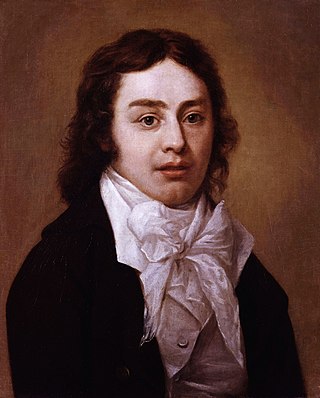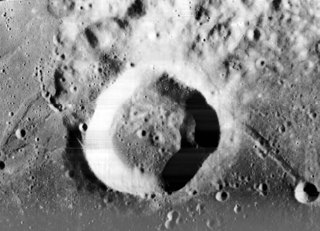Samuel Taylor Coleridge (1772–1834) was an English poet, literary critic, philosopher and theologian.

Kubla Khan: or A Vision in a Dream is a poem written by Samuel Taylor Coleridge, completed in 1797 and published in 1816. It is sometimes given the subtitles "A Vision in a Dream" and "A Fragment." According to Coleridge's preface to Kubla Khan, the poem was composed one night after he experienced an opium-influenced dream after reading a work describing Shangdu, the summer capital of the Mongol-led Yuan dynasty of China founded by Kublai Khan. Upon waking, he set about writing lines of poetry that came to him from the dream until he was interrupted by "a person from Porlock". The poem could not be completed according to its original 200–300 line plan as the interruption caused him to forget the lines. He left it unpublished and kept it for private readings for his friends until 1816 when, at the prompting of Lord Byron, it was published.

Samuel Taylor Coleridge was an English poet, literary critic, philosopher, and theologian who, with his friend William Wordsworth, was a founder of the Romantic Movement in England and a member of the Lake Poets. He also shared volumes and collaborated with Charles Lamb, Robert Southey, and Charles Lloyd.

William Wordsworth was an English Romantic poet who, with Samuel Taylor Coleridge, helped to launch the Romantic Age in English literature with their joint publication Lyrical Ballads (1798).

The Rime of the Ancient Mariner is the longest major poem by the English poet Samuel Taylor Coleridge, written in 1797–98 and published in 1798 in the first edition of Lyrical Ballads. Some modern editions use a revised version printed in 1817 that featured a gloss. Along with other poems in Lyrical Ballads, it is often considered a signal shift to modern poetry and the beginning of British Romantic literature.

John Duke Coleridge, 1st Baron Coleridge, PC was an English lawyer, judge and Liberal politician. He held the posts, in turn, of Solicitor-General for England, Attorney-General for England, Chief Justice of the Common Pleas and Lord Chief Justice of England.

Baron Coleridge, of Ottery St Mary in the County of Devon, is a title in the Peerage of the United Kingdom. It was created in 1874 for the prominent lawyer, judge and Liberal politician Sir John Coleridge. He served as Lord Chief Justice of England from 1880 to 1894. His son, the second Baron, represented Attercliffe in the House of Commons and served as a Judge of the High Court of Justice. As of 2010 the title is held by the latter's great-grandson, the fifth Baron, who succeeded in 1984.

Lyrical Ballads, with a Few Other Poems is a collection of poems by William Wordsworth and Samuel Taylor Coleridge, first published in 1798 and generally considered to have marked the beginning of the English Romantic movement in literature. The immediate effect on critics was modest, but it became and remains a landmark, changing the course of English literature and poetry. The 1800 edition is famous for the Preface to the Lyrical Ballads, something that has come to be known as the manifesto of Romanticism.

Samuel Coleridge-Taylor was a British composer and conductor. Of mixed-race descent, Coleridge-Taylor achieved such success that he was referred to by white musicians in New York City as the "African Mahler" when he had three tours of the United States in the early 1900s. He was particularly known for his three cantatas on the epic 1855 poem The Song of Hiawatha by American Henry Wadsworth Longfellow. Coleridge-Taylor premiered the first section in 1898, when he was 23. He married an Englishwoman, Jessie Walmisley, and both their children had musical careers. Their son Hiawatha adapted his father's music for a variety of performances. Their daughter Avril Coleridge-Taylor became a composer-conductor.

Lake Coleridge is located in inland Canterbury, in New Zealand's South Island. Located 35 kilometres (22 mi) to the northwest of Methven, it has a surface area of 47 square kilometres (18 sq mi). The lake is situated in an over-deepened valley formed by a glacier over 20,000 years ago in the Pleistocene era. It currently has no natural outflows. There is a small settlement at the lake.

Lunar craters are impact craters on Earth's Moon. The Moon's surface has many craters, all of which were formed by impacts. The International Astronomical Union currently recognizes 9,137 craters, of which 1,675 have been dated.
Samuel Taylor Coleridge was born on 21 October 1772. The youngest of 14 children, he was educated after his father's death and excelled in classics. He attended Christ's Hospital and Jesus College, Cambridge. While attending college, he befriended two other Romanticists, Charles Lamb and Robert Southey, the latter causing him to eventually drop out of college and pursue both poetic and political ambitions.
Sonnets on Eminent Characters or Sonnets on Eminent Contemporaries is an 11-part sonnet series created by Samuel Taylor Coleridge and printed in the Morning Chronicle between 1 December 1794 and 31 January 1795. Although Coleridge promised to have at least 16 poems within the series, only one addition poem, "To Lord Stanhope", was published.

Ma Chih-Yuan is a crater on Mercury. Its name was adopted by the International Astronomical Union (IAU) in 1976. Ma Chih-Yuan is named for the Chinese playwright Ma Zhiyuan, who lived in the 13th century CE.
Romantic epistemology emerged from the Romantic challenge to both the static, materialist views of the Enlightenment (Hobbes) and the contrary idealist stream (Hume) when it came to studying life. Romanticism needed to develop a new theory of knowledge that went beyond the method of inertial science, derived from the study of inert nature, to encompass vital nature. Samuel Taylor Coleridge was at the core of the development of the new approach, both in terms of art and the 'science of knowledge' itself (epistemology). Coleridge's ideas regarding the philosophy of science involved Romantic science in general, but Romantic medicine in particular, as it was essentially a philosophy of the science(s) of life.
Coleridge's theory of life is an attempt by Samuel Taylor Coleridge to understand not just inert or still nature, but also vital nature. He examines this topic most comprehensibly in his work Hints towards the Formation of a more Comprehensive Theory of Life (1818). The work is key to understand the relationship between Romantic literature and science.

Rabelais is a crater on Mercury. It has a diameter of 154 kilometres. Its name was adopted by the International Astronomical Union (IAU) in 1976. Rabelais is named for the French writer François Rabelais.












